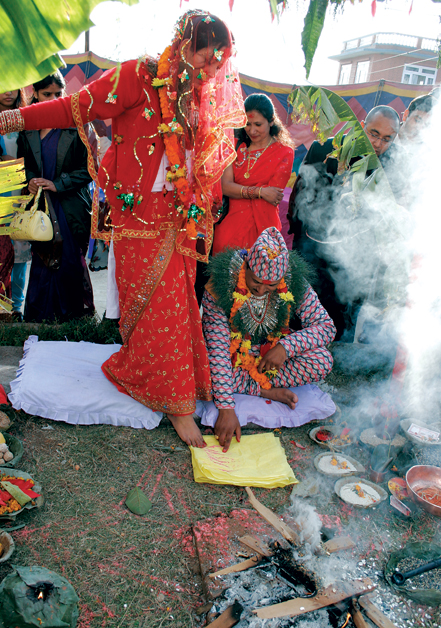
A Traditional Hindu Wedding
If marriages are made in heaven, it is literally so in the Hindu system because of the belief that all major events of life are influenced by heavenly bodies; that is, by the stars, planets, moons and so on. Strict adherence to astrological and ritual aspects of the Vedas, holy scriptures dating back 5,000 years or more, stands proof to this belief system. Hindu marriage is a cumbersome process. A simple task of fixing the marriage date, for example, calls for a consultation with an astrologer who is not a family member and at times a total stranger. He decides on an auspicious date, or Subha Sahit, after gauging the influences of the celestial bodies on the bride and groom based on the dates and times of their birth. Fixing the date is but an end of a long, tedious process of setting everything on a right course. Preceding it are labyrinth of activities, like matching of kundalis and comparing and cross-checking of gotras, or ancestral lineages, of the couple. Marriages within same gotras up to five or six generations are considered unholy and unhealthy.
After matching the kundalis and zeroing in on the Subha Sahit, another custom is Kura Chhinne or engagement ceremony. Purohits or Brahmin priests of both families arrange a meeting at the bride’s place. The groom’s priest pays a visit (a mock one these days) along with his brothers, cousins and friends.
After some lyrical exchanges and deliberation, the bride’s father accepts the proposal made on groom’s behalf and offers paan and supari (betal and areca nuts) by way of invitation.
On the wedding day, the janti or procession, consisting of the groom’s family members, relatives and friends, sets out for the bride’s home. The euphoric procession, usually accomapnied by a musical band, indulges in dance and merrymaking all along the way. The procession stops a few hundred yards from the bride’s place and a group of five or six is sent with fruits and a letter informing the janti’s arrival and urging them to get ready for the welcome. This group, also called bhatkhaure, is required to inform those in charge of the preparations the number of people in the procession and to take the stock of the situation by tasting the hospitality before others. For fun sake the bhatkhaures are served tea laced with hot spices and offered a seat on the floor that either has mustard seed or throny bushes underneath covered by a thin sheet of cloth. The bhatkhaures than lead the groom and the others to the bride’s house.
The bride’s house, the marriage venue, is studded with bright twinkling lights and colorful papers cut in different shapes.
On a small street of Kathmandu members of an orchestra, dressed in red and white attire, playing brass and folk instruments work up a tune from a popular Hindi song that roughly translates as: “Will take away, will take away, the hearty will take away the bride.” Following them, tipsy youngsters dance freely and curse the cold weather. Not far behind is a latest, gleaming white Maruti decorated ornately with colorful flowers, real and those made of paper. On the doors both sides, large initials in thin red and blue paper are pasted: “P+K”. A few paces back are elders, women, girls, children and the groom’s friends in procession. Passers-by and chatting by-standers pause to look and look to pause, respectively. Above, onlookers from the houses along the street stick their heads out from the windows and terraces to get a better view. On the back seat of the car the groom, in a three piece suit and traditional Nepali cap, looks cheerful and a little anxious. A dash of a tika dots his forehead, and garlands wreathed out of seasonal flowers and dubo (an evergreen grass) is draped around his neck covering his shoulders. It is wedding time and the groom is on his way to take his bride away with him.
No comments:
Post a Comment